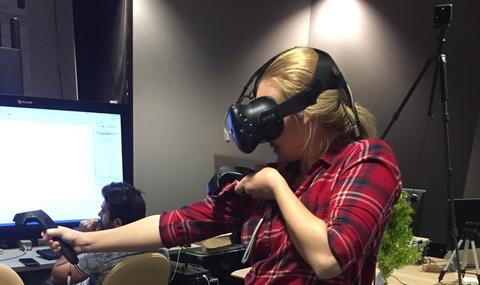
The road so far — NIST postdoctoral associate Kate Kapalo followed an unconventional path into research for public safety, but the experiences fuel her projects today. Trace her steps with us:
Part I: Getting Psychological
Making her way through undergrad at the University of Central Florida, Kate discovered human factors psychology, which applies psychological and physiological processes to the design of tools, products and systems. With a bachelor’s degree under her belt, she followed others in her field into the defense sector and interned at the Naval Postgraduate School.
Many in this space study soldiers’ interactions with technology such as robots. Kate helped to coordinate an interagency collaboration with the Department of Homeland Security to test out technology use during wildfire and earthquake scenarios, where she was first exposed to the amount of planning that goes into disaster response.
Part II: Techno Talk
Early on in Kate’s undergraduate internship, she realized that she had entered a multidisciplinary field that required an equally multidisciplinary education. Software engineers spoke a different language, and she wanted to understand how they approached problems. Building on her psychology background, Kate pivoted to computer science and simulation in her graduate studies and learned how to use computer science tools for evaluating human cognition.
Returning to the Navy as a civilian research psychologist, Kate specialized in augmented reality for aviation and undersea war fighters.
Part III: The Call for Help
Kate remained with the Navy for a time, but the call for help in the public safety field was too strong to ignore. She transitioned into a research statistician position with the Orange County Fire Rescue Department, Florida for two years before coming to us.
Part IV: Virtually Real
At NIST, we have a team of researchers developing simulated emergencies in virtual reality that can be used to test out emerging technologies (laptops, headsets, etc.) for future real-world crises. But to accurately evaluate the tech, we need an accurate picture of an incident.
To Kate, the adrenaline rush and stress that first responders experience at an emergency can’t be fully grasped unless you, yourself, have been on the scene. She pulls from her background with the Navy and DHS to ensure that these simulated environments are as close to the real thing as possible. Then, she sees how the tech stands up against extreme conditions for the human using it.
Fires, floods, medical crises, mass-transit accidents, active shooter incidents — public safety professionals need the best tools when they respond to every kind of emergency. Kate and her team are on the job to evaluate that equipment’s quality before first responders head into the field with it.
Follow us on social media for more like this from all across NIST!

